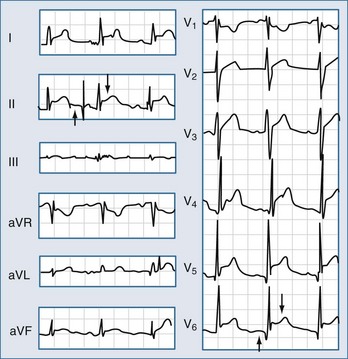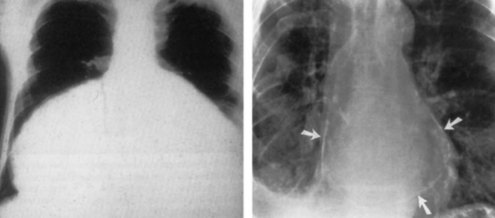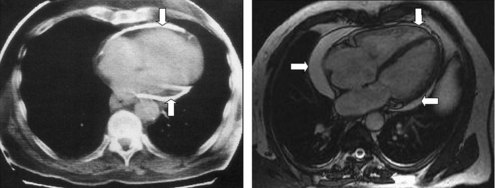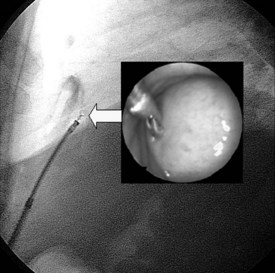85 Pericardial Diseases
 Etiology and Classification of Pericardial Disease
Etiology and Classification of Pericardial Disease
The spectrum of pericardial diseases consists of congenital defects, pericarditis (dry, effusive, effusive-constrictive, constrictive), neoplasm, and cysts. The etiologic classification comprises infectious pericarditis, pericarditis in systemic autoimmune diseases, type 2 (auto) immune process, post-myocardial infarction syndrome, and autoreactive (chronic) pericarditis.1–3
 Pericardial Syndromes
Pericardial Syndromes
Congenital Defects of the Pericardium
Congenital defects of the pericardium occur in 1 in 10,000 autopsies. Pericardial absence can be partial left (70%), right (17%), or total bilateral (rare). Additional congenital abnormalities occur in approximately 30% of patients.4 Most patients with a total pericardial absence are asymptomatic. Homolateral cardiac displacement and augmented heart mobility impose an increased risk for traumatic aortic dissection.5 Partial left-side defects can be complicated by herniation and strangulation of the heart through the defect (chest pain, shortness of breath, syncope, or sudden death). Surgical pericardioplasty (Dacron, Gore-Tex, or bovine pericardium) is indicated for imminent strangulation.6
Acute Pericarditis
Acute pericarditis is dry, fibrinous, or effusive, independent of its etiology. Major symptoms are retrosternal or left pre-cordial chest pain (which radiates to the trapezius ridge, can be pleuritic or simulate ischemia, and varies with posture) and shortness of breath. A prodrome of fever, malaise, and myalgia is common, but elderly patients may not be febrile. The pericardial friction rub can be transient and monophasic, biphasic, or triphasic. Pleural effusion may be present. Heart rate is usually rapid and regular. Echocardiography is essential to detect effusion and concomitant heart or paracardial disease (Table 85-1).7–19
TABLE 85-1 Diagnostic Pathway and Sequence of Performance in Acute Pericarditis
| Diagnostic Measure | Characteristic Findings |
|---|---|
| Obligatory | |
| Auscultation | Pericardial rub (monophasic, biphasic, or triphasic) |
| ECG* | Stage I: anterior and inferior concave ST segment elevation. PR segment deviations opposite to P wave polarity |
| Early stage II: all ST junctions return to the baseline. PR segments deviated. | |
| Late stage II: T waves progressively flatten and invert | |
| Stage III: generalized T wave inversions in most or all leads | |
| Stage IV: ECG returns to prepericarditis state | |
| Echocardiography | Effusion types B to D (Horowitz) |
| Signs of tamponade | |
| Blood analyses | Erythrocyte sedimentation rate, C-reactive protein, lactate dehydrogenase, leukocytes (inflammation markers) |
| Troponin I†, CK-MB (markers of myocardial involvement) | |
| Chest radiograph | Ranging from normal to “water bottle” shape of the heart shadow |
| Performed primarily to reveal pulmonary or mediastinal pathology | |
| Mandatory in Tamponade, Optional in Large/Recurrent Effusions or if Previous Tests Inconclusive in Small Effusions | |
| Pericardiocentesis/drainage | Polymerase chain reaction and histochemistry for etiopathogenetic classification of infection or neoplasia |
| Optional or if Previous Tests Inconclusive | |
| CT | Effusions, pericardium, and epicardium |
| MRI | Effusions, pericardium, and epicardium |
| Pericardioscopy, pericardial/epicardial biopsy | Establishing the specific etiology |
* Typical lead involvement: I, II, aVL, aVF, and V3-V6. The ST segment is always depressed in aVR frequently in V1, and occasionally in V2. Stage IV may not occur, and there are permanent T wave inversions and flattenings. If ECG is first recorded in stage III, pericarditis cannot be differentiated by ECG from diffuse myocardial injury, “biventricular strain,” or myocarditis. ECG in early repolarization is very similar to stage I. Unlike stage I, this ECG does not acutely evolve and J-point elevations are usually accompanied by a slur, oscillation, or notch at the end of the QRS just before and including the J point (best seen with tall R and T waves—large in early repolarization pattern). Pericarditis is likely if in lead V6 the J point is greater than 25% of the height of the T wave apex (using the PR segment as a baseline).
† A cTnI rise was detectable in 38/118 patients (32.2%), more frequently in younger, male patients, with ST-segment elevation and pericardial effusion at presentation. An increase beyond 1.5 ng/mL was rare (7.6%), and associated with CK-MB elevation. cTnI increase was not a negative prognostic marker regarding the incidence of recurrences, constrictive pericarditis, cardiac tamponade, or residual left ventricular dysfunction (Imazio). Data from references 2, 3, and 7 to 19.
Hospitalization and symptomatic treatment is warranted. Nonsteroidal anti-inflammatory drugs (NSAIDs) are the mainstay. Indomethacin should be avoided in elderly patients, owing to its effect on reducing flow in the coronaries. Ibuprofen (300 to 800 mg tid) is preferred for its rare side effects, favorable impact on coronary flow, and large dose range.7 Colchicine 0.5 mg at least twice daily for 3 months added to an NSAID or to aspirin reduced the recurrence rate impressively in the COPE trial20 even at the first episode of pericarditis or even as monotherapy in “idiopathic” effusions. It is well tolerated with fewer side effects than NSAIDs. Systemic corticosteroids should be restricted to connective tissue diseases and autoreactive or uremic pericarditis. Intrapericardial steroid application as long-acting crystalloid triamcinolone is effective for autoreactive effusions and avoids systemic side effects.2
Chronic Pericarditis
Chronic (>3 months) pericarditis includes effusive (inflammatory or hydropericardium in heart failure), adhesive, and constrictive forms.7 Symptoms are usually mild (chest pain, palpitations, fatigue), related to the degree of cardiac compression and pericardial inflammation. The detection of the curable causes (e.g., tuberculosis, toxoplasmosis, myxedema, viral, autoimmune, and systemic diseases) allows successful specific therapy. Symptomatic treatment and pericardiocentesis should be applied if indicated. For recurrences the etiology should be investigated intensely and if no specific therapy is effective, balloon pericardiotomy or pericardiectomy may be considered.22,23
Recurrent Pericarditis
The term recurrent pericarditis encompasses (1) the intermittent type (symptom-free intervals without therapy) and (2) the incessant type (discontinuation of anti-inflammatory therapy ensures a relapse). Massive pericardial effusion, overt tamponade, or constriction is rare. Symptomatic management relies on exercise restriction and the regimen used in acute pericarditis. Colchicine may be effective when NSAIDs and corticosteroids failed to prevent relapses.20,21,24,25 It should be considered first-choice treatment for recurrent pericarditis according to the CORE trial.21 Corticosteroids should be used only in patients with poor general condition or in frequent crises.7 A common mistake could be to use a dose too low to be effective or to taper the dose too rapidly. The recommended regimen is prednisone, 1 to 1.5 mg/kg, for at least 1 month. If patients do not respond adequately, azathioprine (75 to 100 mg/day) or cyclophosphamide can be added.26
Corticosteroids should be tapered over a 3-month period. Toward the end of the taper, introduce antiinflammatory treatment with colchicine (0.5 mg bid or tid) or an NSAID. Renewed treatment should continue for 3 to 6 months. Recently it was demonstrated in “idiopathic” pericarditis that previous corticoid treatment was even a risk factor for recurrence or chronicity. Therefore corticoids should be administered after definite exclusion of viral or bacterial infection of the pericardium. Pericardiectomy is indicated only in frequent and highly symptomatic recurrences resistant to medical treatment.27
Pericardial Effusion and Cardiac Tamponade
Pericardial effusion may appear as transudate (hydropericardium), exudate, pyopericardium, or hemopericardium. Large effusions are common with neoplastic, tuberculous, cholesterol, uremic, myxedema, and parasitoses pericarditis.28 Loculated effusions are more common when scarring has supervened (e.g., postsurgical, post trauma, purulent pericarditis). Effusions that develop slowly can be remarkably symptomatic, whereas rapidly accumulating smaller effusions can present as tamponade. Cardiac tamponade is the decompensated phase of cardiac compression caused by effusion accumulation and the increased intrapericardial pressure. Heart sounds are distant. Orthopnea, cough, and dysphagia, occasionally with episodes of unconsciousness, can be observed. Insidiously developing tamponade may present as the signs of its complications (renal failure, abdominal plethora, shock liver, worsening of glaucoma,29 and mesenteric ischemia). Tamponade without two or more inflammatory signs (typical pain, pericardial friction rub, fever, diffuse ST-segment elevation) is usually associated with a malignant effusion (likelihood ratio 2.9).30
Electrocardiography demonstrates low QRS and T-wave voltages, PR-segment depression (Figure 85-1), ST-segment/T-wave changes, bundle branch block, and electrical alternans (rarely seen in the absence of tamponade).7 Microvoltage and electrical alternans are reversible after effusion drainage and resolution of the inflammatory process.19 In chest radiography large effusions are depicted as globular cardiomegaly with sharp margins (“water bottle” silhouette) (Figure 85-2).12 The size of effusions can be graded in echocardiography as (1) small (echo-free space in diastole < 10 mm), (2) moderate (10 to 20 mm) (Figure 85-3), (3) large (≥20 mm), or (4) very large (≥20 mm and compression of the heart). In large pericardial effusions, the heart may move freely within the pericardial cavity (“swinging heart”) inducing pseudoprolapse and pseudosystolic anterior motion of the mitral valve, paradoxical motion of the inter-ventricular septum, and midsystolic aortic valve closure (Table 85-2).31–41 Up to one third of patients with an asymptomatic large pericardial chronic effusion develop unexpected cardiac tamponade.22 Triggers for tamponade include hypovolemia, paroxysmal tachyarrhythmia, and intercurrent acute pericarditis.
| Clinical presentation | Elevated systemic venous pressure,* hypotension,† pulsus paradoxus,‡ tachycardia,§ dyspnea, or tachypnea with clear lungs |
| Precipitating factors | Drugs (cyclosporine, anticoagulants, thrombolytics), recent cardiac surgery, indwelling instrumentation, blunt chest trauma, malignancies, connective tissue disease, renal failure, septicemia|| |
| ECG | Can be normal or nonspecifically changed (ST-T wave), electrical alternans (QRS, rarely T), bradycardia (end stage), electromechanical dissociation (agonal phase) |
| Chest radiograph | Enlarged cardiac silhouette with clear lungs |
| M-mode/two-dimensional echocardiogram | Diastolic collapse of the anterior RV free wall,¶ RA collapse, LA and rarely LV collapse, increased LV diastolic wall thickness “pseudohypertrophy,” IVC dilatation (no collapse in inspiration),“swinging heart” |
| Doppler | Tricuspid flow increases and mitral flow decreases during inspiration (reverse in expiration) |
| Systolic and diastolic flows are reduced in systemic veins in expiration and reverse flow with atrial contraction is increased | |
| M-mode color Doppler | Large respiratory fluctuations in mitral/tricuspid flows |
| Cardiac catheterization | Confirmation of the diagnosis and quantification of the hemodynamic compromise |
| RA pressure is elevated (preserved systolic × descent and absent or diminished diastolic y descent) | |
| Intrapericardial pressure is also elevated and virtually identical to RA pressure (both pressures fall in inspiration) | |
| RV mid-diastolic pressure is elevated and equal to the RA and pericardial pressures (no dip-and-plateau configuration) | |
| Pulmonary artery diastolic pressure is slightly elevated and may correspond to the RV pressure | |
| Pulmonary capillary wedge pressure is also elevated and nearly equal to intrapericardial and right atrial pressure | |
| LV systolic and aortic pressures may be normal or reduced | |
| Documenting that pericardial aspiration is followed by hemodynamic improvement** | |
| Detection of coexisting hemodynamic abnormalities (LV failure, constriction, pulmonary hypertension) | |
| Detection of associated cardiovascular diseases (cardiomyopathy, coronary artery disease) | |
| RV/LV angiography | Atrial collapse and small hyperactive ventricular chambers |
| Coronary angiography | Coronary compression in diastole |
LA, left atrium; LV, left ventricle; RA, right atrium; RV, right ventricle; IVC, inferior vena cava.
* Jugular venous distention is less notable in hypovolemic patients or in “surgical tamponade.” An inspiratory increase or lack of fall of the pressure in the neck veins (Kussmaul sign), when verified with tamponade or after pericardial drainage, indicates effusive-constrictive disease.
† Heart rate is usually greater than 100 beats/min but may be lower in hypothyroidism and in uremic patients.
‡ Pulsus paradoxus is defined as a drop in systolic blood pressure greater than 10 mm Hg during inspiration, whereas diastolic blood pressure remains unchanged. It is easily detected by simply feeling the pulse, which diminishes significantly during inspiration. Clinically significant pulsus paradoxus is apparent when the patient is breathing normally. When this sign is present only in deep inspiration it should be interpreted with caution. The magnitude of pulsus paradoxus is evaluated by sphygmomanometry. If the pulsus paradoxus is present, the first Korotkoff sound is not heard equally well throughout the respiratory cycle, but only during expiration at a given blood pressure. The blood pressure cuff is therefore inflated above the patient’s systolic pressure. Then it is slowly deflated while the clinician observes the phase of respiration. During deflation, the first Korotkoff sound is intermittent. Correlation with the patient’s respiratory cycle identifies a point at which the sound is audible during expiration but disappears when the patient breathes in. As the cuff pressure drops farther, another point is reached when the first blood pressure sound is audible throughout the respiratory cycle. The difference in systolic pressure between these two points is the clinical measure of pulsus paradoxus. Pulsus paradoxus is absent in tamponade, complicating atrial septal defect, and in patients with significant aortic regurgitation.
§ Occasional patients are hypertensive, especially if they have preexisting hypertension.
|| Febrile tamponade may be misdiagnosed as septic shock.
¶ Right ventricular collapse can be absent in elevated right ventricular pressure and right ventricular hypertrophy or in right ventricular infarction.
** If after drainage of pericardial effusion intrapericardial pressure does not fall below atrial pressure, the effusive-constrictive disease should be considered.
Constrictive Pericarditis
Constrictive pericarditis is a rare but severely disabling consequence of the chronic inflammation of the pericardium, leading to an impaired filling of the ventricles and reduced ventricular function. Until recently, increased pericardial thickness has been considered an essential diagnostic feature of constrictive pericarditis. However, in the large surgical series from the Mayo Clinic constriction was present in 18% of the patients with normal pericardial thickness.42 Tuberculosis, mediastinal irradiation, and previous surgical procedures are frequent.43 Constrictive pericarditis may rarely develop only in the epicardial layer in patients with previously removed parietal pericardium.44 Transient constrictive pericarditis is an uncommon but important entity, because pericardiectomy is not indicated in these patients.45
Patients complain about fatigue, peripheral edema, breathlessness, and abdominal swelling, which may be aggravated by a protein-losing enteropathy. In decompensated patients venous congestion, hepatomegaly, pleural effusions, and ascites may occur. Hemodynamic impairment can be additionally aggravated by a systolic dysfunction due to myocardial fibrosis or atrophy. Differential diagnosis has to include acute dilatation of the heart, pulmonary embolism, right ventricular infarction, pleural effusion, chronic obstructive lung diseases,46 and restrictive cardiomyopathy. The best way to distinguish constrictive pericarditis from restrictive cardiomyopathy is the analysis of respiratory changes with or without changes of preload by Doppler and/or tissue Doppler echocardiography,47 but physical findings, electrocardiogram (ECG), chest radiography (see Figure 85-2, Right), computed tomography (CT) (Figure 85-4, Left), magnetic resonance imaging (MRI) (see Figure 85-4, Right), hemodynamics, and endomyocardial biopsy may be helpful as well.7
Pericardiectomy is the only treatment for permanent constriction. The indications are based on clinical symptoms, echocardiography findings, CT/MRI, and heart catheterization. A primary installation of cardiopulmonary bypass (CPB) is not recommended (diffuse bleeding following systemic heparinization). Pericardiectomy for constrictive pericarditis has a mortality rate of 6% to 12%.48–51 The complete normalization of cardiac hemodynamics is reported in only 60% of patients.48,50 Major complications include acute perioperative cardiac insufficiency and ventricular wall rupture.52 Cardiac mortality and morbidity at pericardiectomy are mainly caused by the presurgically unrecognized presence of myocardial atrophy or myocardial fibrosis.43 Exclusion of patients with extensive myocardial fibrosis and/or atrophy reduced the mortality rate for pericardiectomy to 5%. Postoperative low cardiac output52 should be treated by fluid substitution and catecholamines, high doses of digitalis, and intra-aortic balloon pump in most severe cases. If the indication for surgery is established early, long-term survival after pericardiectomy corresponds to that of the general population.49,50 However, if severe clinical symptoms were present for a longer period before surgery, even a complete pericardiectomy may not achieve a total restitution.
Pericardial Cysts
Congenital pericardial cysts are uncommon; they may be unilocular or multilocular, with the diameter ranging from 1 to 5 cm.53 Inflammatory cysts comprise pseudocysts as well as encapsulated and loculated pericardial effusions, caused by rheumatic pericarditis, bacterial infection, particularly tuberculosis, trauma, and cardiac surgery. Most patients are asymptomatic and cysts are detected incidentally on chest radiographs as an oval, homogeneous radiodense lesion, usually at the right cardiophrenic angle.54 However, the patients can also present as chest discomfort, dyspnea, cough, or palpitations, owing to the compression of the heart. Echocardiography is useful, but additional imaging by CT (density readings) or MRI is often needed.55 The treatment of congenital and inflammatory cysts is percutaneous aspiration and ethanol sclerosis.56,57 If this is not feasible, video-assisted thoracotomy or surgical resection may be necessary. Echinococcal cysts usually originate from ruptured hydatid cysts in the liver and lungs. Their surgical excision is not recommended, instead percutaneous aspiration and instillation of ethanol or silver nitrate after pretreatment with albendazole (800 mg/day 4 weeks) is recommended.57
 Specific Forms of Pericarditis
Specific Forms of Pericarditis
Viral Pericarditis
Viral pericarditis is the most common infection of the pericardium. Inflammatory abnormalities are due to direct viral attack, the immune response (antiviral or anticardiac), or both.3,58 Early viral replication in pericardial and epimyocardial tissue elicits cellular and humoral immune responses against the virus and/or cardiac tissue. Deposits of IgM, IgG, and occasionally IgA can be found in the pericardium and myocardium for years.58 Various viruses can cause pericarditis (e.g., enteroviruses, echoviruses, adenoviruses, cytomegaloviruses, Epstein-Barr virus, herpes simplex, herpes humanus 6(HHV6), influenzaviruses, parvovirus B19(PVB19), hepatitis C, human immunodeficiency virus [HIV]), whereby in the last few years PVB19 and HHV6 have been increasing and entero-, echo- and adenoviruses have been decreasing as has also been observed in myocarditis. Attacks of enteroviral pericarditis follow the seasonal epidemics of coxsackievirus A+B and echovirus infections.59 Cytomegalovirus (CMV) pericarditis has an increased incidence in immunocompromised and HIV-infected hosts.60 Infectious mononucleosis may also present as pericarditis.
Treatment of viral pericarditis is directed to resolve symptoms (see acute pericarditis), prevent complications, and eradicate the virus. In patients with chronic or recurrent symptomatic pericardial effusion and confirmed viral infection the following specific treatment is under investigation61:
Pericardial manifestations of HIV infection can be due to infective, noninfective, and neoplastic diseases (Kaposi’s sarcoma and/or lymphoma). Infective (myo) pericarditis results from the local HIV infection and/or from other viral, bacterial (Staphylococcus aureus, Klebsiella pneumoniae, Mycobacterium avium, and M. tuberculosis), and fungal co-infections (Cryptococcus neoformans).62 In progressive disease the incidence of echocardiographically detected pericardial effusion may be up to 40%.63 Cardiac tamponade is rare.64 During treatment with retroviral compounds, lipodystrophy can develop (best demonstrated by MRI) with intense paracardial fat deposition leading to heart failure. Treatment is symptomatic, whereas in large effusions and cardiac tamponade pericardiocentesis is necessary. The use of corticosteroid therapy is contraindicated except in patients with secondary tuberculous pericarditis, as an adjunct to tuberculostatic treatment.65
Bacterial Pericarditis
Purulent pericarditis in adults is rare but always fatal if not treated.66–69 The mortality rate in treated patients is 40%, mostly due to cardiac tamponade, toxicity, and constriction. It is usually a complication of an infection originating elsewhere in the body, arising by contiguous spread or hematogenous dissemination.70 Predisposing conditions are pericardial effusion, immunosuppression, chronic diseases (e.g., alcohol abuse, rheumatoid arthritis), cardiac surgery, and chest trauma. The disease appears as an acute, fulminant infectious illness with short duration. Percutaneous pericardiocentesis must be promptly performed, and obtained pericardial fluid should undergo Gram, acid-fast, and fungal staining, followed by cultures of the pericardial and body fluids. Rinsing of the pericardial cavity, combined with effective systemic antibiotic therapy is mandatory (antistaphylococcal antibiotic plus aminoglycoside, followed by tailored antibiotic therapy according to pericardial fluid and blood cultures).67 Intrapericardial instillation of antibiotics (e.g., gentamicin) is useful but not sufficient. Frequent irrigation of the pericardial cavity with urokinase or streptokinase, using large catheters, may liquefy the purulent exudate,68,69 but open surgical drainage through subxiphoid pericardiotomy is preferable.66 Pericardiectomy is required in patients with dense adhesions, loculated and thick purulent effusion, recurrence of tamponade, persistent infection, and progression to constriction.67 Surgical mortality is up to 8%.
Tuberculous Pericarditis
In the past decade, tuberculous pericarditis in developed countries has been primarily seen in immunocompromised patients (acquired immunodeficiency syndrome [AIDS]).71 The mortality rate in untreated effusive tuberculous pericarditis approaches 85%. Pericardial constriction occurs in 30% to 50%.72,73
The clinical presentation is variable: acute pericarditis with or without effusion; cardiac tamponade; silent, often large pericardial effusion with a relapsing course; toxic symptoms with persistent fever; acute constrictive pericarditis; subacute constriction; effusive-constrictive or chronic constrictive pericarditis; and pericardial calcifications.3,74 The diagnosis is made by the identification of M. tuberculosis in the pericardial fluid or tissue and/or the presence of caseous granulomas in the pericardium.71 Importantly, PCR can identify DNA of M. tuberculosis rapidly from only 1 µl of pericardial fluid.75,76 Increased adenosine deaminase activity and interferon gamma concentration in pericardial effusion are also diagnostic, with a high sensitivity and specificity. Both pericardioscopy and pericardial biopsy have also improved the diagnostic accuracy for tuberculous pericarditis (Figure 85-5).15 Pericardial biopsy enables rapid diagnosis with better sensitivity than pericardiocentesis (100% vs. 33%).
Pericarditis in a patient with proven extracardiac tuberculosis is strongly suggestive of tuberculous etiology (several sputum cultures should be taken).77






